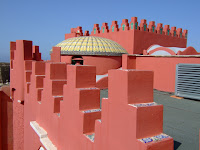
The sky was no bluer today than yesterday so our photos could not be improved upon.
 Nevertheless we went for another wander through the trulli areas of town before leaving town in the direction of Bari. Murray's Dad served the last few months of WWII in a hospital based at the Bari Polyclinic. The Polyclinic still occupies the same site so we thought we should at least call by since we were so close. We knew, from war archive data on the web, exactly where the medical stores were based so headed for that part of the site.
Nevertheless we went for another wander through the trulli areas of town before leaving town in the direction of Bari. Murray's Dad served the last few months of WWII in a hospital based at the Bari Polyclinic. The Polyclinic still occupies the same site so we thought we should at least call by since we were so close. We knew, from war archive data on the web, exactly where the medical stores were based so headed for that part of the site.  The traffic into Bari and around the hospital was horrendous but we found the particular part of the hospital without getting lost in the one-way system, took some photos in the rain and left.
The traffic into Bari and around the hospital was horrendous but we found the particular part of the hospital without getting lost in the one-way system, took some photos in the rain and left.A little way to the north of Bari was our last World Heritage site, Castel del Monte. An amazing and intriguing structure build in 1240 by Emperor Frederick II. It is entirely composed of octagons: eight octagonal towers positioned around the corners of an octagonal building, of eight rooms, that enclosed an octagonal courtyard with walls eighty feet high. No one is quite sure why it was built that way or, in fact, why it was built at all. It is not defensive and it has no kitchen, storerooms or servants quarters - so was probably not lived in. Theorists have pointed out that it is built
 at the intersection of two great alignments: halfway between Stonehenge and the Great Pyramid of Egypt; and halfway between Jerusalem and Mont St Michel. "The truth is out there somewhere." Unfortunately the day had not improved by the time we arrived so once again the pictures lack the blue Mediterranean sky.
at the intersection of two great alignments: halfway between Stonehenge and the Great Pyramid of Egypt; and halfway between Jerusalem and Mont St Michel. "The truth is out there somewhere." Unfortunately the day had not improved by the time we arrived so once again the pictures lack the blue Mediterranean sky.Our official itinerary was now complete but as we still had quite a bit of day before our flight left, we headed out to the coast rather than straight back to
 Bari and enjoyed a leisurely drive along the coast past several fishing ports and finally stopping for pizza at Santo Spirito. The fish market was in full swing with the fishermen selling their catch from stalls right on the water's edge. The fish were so fresh that many were still flapping on the counters.
Bari and enjoyed a leisurely drive along the coast past several fishing ports and finally stopping for pizza at Santo Spirito. The fish market was in full swing with the fishermen selling their catch from stalls right on the water's edge. The fish were so fresh that many were still flapping on the counters.The inevitable could not be delayed much longer so it was off to the airport for the tedious business of queuing and waiting that is air travel these days.

















































